

The Hobbit: How England inspired Tolkien's Middle-earth. Small hairy feet will be back on screen again as The Hobbit: The Battle of the Five Armies marches into cinemas worldwide next week.
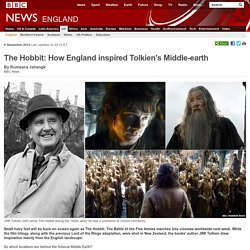
While the film trilogy, along with the previous Lord of the Rings adaptation, were shot in New Zealand, the books' author JRR Tolkien drew inspiration mainly from the English landscape. The Shire Tolkien described the area around Sarehole Mill, still in operation, as "a kind of lost paradise" Born in Slavery: Slave Narratives from the Federal Writers' Project - Collection Connections. Collection Overview Born in Slavery: Slave Narratives from the Federal Writers' Project, 1936-1938, contains more than 2,300 first-person accounts of slavery and 500 black-and-white photographs of former slaves collected as part of the Federal Writers' Project of the Works Progress Administration.
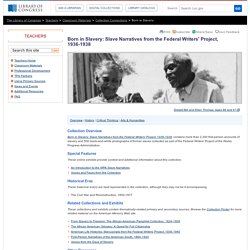
Special Features These online exhibits provide context and additional information about this collection. Historical Eras These historical era(s) are best represented in the collection, although they may not be ll-encompassing. The Civil War and Reconstruction, 1850-1877 Related Collections and Exhibits These collections and exhibits contain thematically-related primary and secondary sources. Other Resources Recommended additional sources of information. Related Resources Search Tips Specific guidance for searching this collection.
To find items in this collection, search by Keyword or browse by Narrator or Volume. For help with general search strategies, see Finding Items in American Memory. Top U.S. . . . Nightjohn Teaching resource sheets - Nightjohn.pdf. Frederick Douglass and Harriet Jacobs: American Slave Narrators, Freedom's Story, TeacherServe®, National Humanities Center. Frederick Douglass and Harriet Jacobs: American Slave Narrators Lucinda MacKethan Alumni Distinguished Professor of English Emerita, North Carolina State University National Humanities Center Fellow ©National Humanities Center During the last three decades of legal slavery in America, from the early 1830s to the end of the Civil War in 1865, African American writers perfected one of the nation’s first truly indigenous genres of written literature: the North American slave narrative.
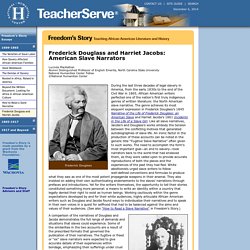
The genre achieves its most eloquent expression in Frederick Douglass’s 1845 Narrative of the Life of Frederick Douglass: an American Slave and Harriet Jacobs’s 1861 Incidents in the Life of a Slave Girl. Like all slave narratives, Jacobs’s and Douglass’s works embody the tension between the conflicting motives that generated autobiographies of slave life. An ironic factor in the production of these accounts can be noted in the generic title “Fugitive Slave Narrative” often given to such works. William L. Hobbits: Tolkien’s Unlikely Heroes. Patricia Briggs writes in her novel entitled Blood Bound that “even after all this time, I keep forgetting that heroes can be found in unlikely places and persons.”
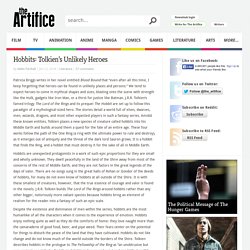
We tend to expect heroes to come in mythical shapes and sizes, blasting onto the scene with strength like the Hulk, gadgets like Iron Man, or a thirst for justice like Batman. J.R.R. Tolkien’s famed trilogy The Lord of the Rings and its prequel The Hobbit are set up to follow this paradigm of a mythological-sized hero. The stories detail a world full of elves, dwarves, men, wizards, dragons, and most other expected players in such a fantasy series. Amidst these known entities, Tolkien places a new species of creature called hobbits into his Middle Earth and builds around them a quest for the fate of an entire age. Hobbits are unexpected protagonists in a work of such epic proportions for they are small and wholly unknown. Carol Ann Duffy's moving tale of World War Christmas truce. It was the poignant moment when enemies at war put aside their differences for a Christmas Day game of football.
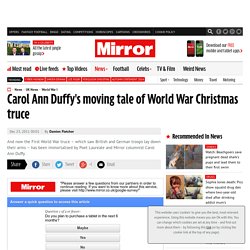
And now the First World War truce – which saw British and German troops lay down their arms – has been immortalised by Poet Laureate and Mirror columnist Carol Ann Duffy. On Christmas Day 1914 soldiers from both sides of the trenches on the Western Front in northern France met up in No Man’s Land for a game of football. As many as 100 troops took part and the game began after each side was heard singing Christmas songs in their trenches. Favorite Snacks of the Great Writers - Interactive Feature. When I sit down to work, I keep a small bowl of garlic croutons on my desk.

These are little rewards for good ideas and strong lines, Pavlovian pellets to keep my spirits up. Recently, I began to wonder what fuel writers have relied on, and the answers turned out to be all over the culinary map. Walt Whitman began the day with oysters and meat, while Gustave Flaubert started off with what passed for a light breakfast in his day: eggs, vegetables, cheese or fruit, and a cup of cold chocolate.
The novelist Vendela Vida told me she swears by pistachios, and Mark Kurlansky, the author of “Salt” and “Cod,” likes to write under the influence of espresso, “as black as possible.” For some writers, less is more. How to Write a Book Blurb.
Love. File 2 travelling. Autobiogaphy LELE File. SItes d'autres profs. Poetry. Literature in English for the ESL classroom 2013-2014. Nadine Gordimer pour la LELE.